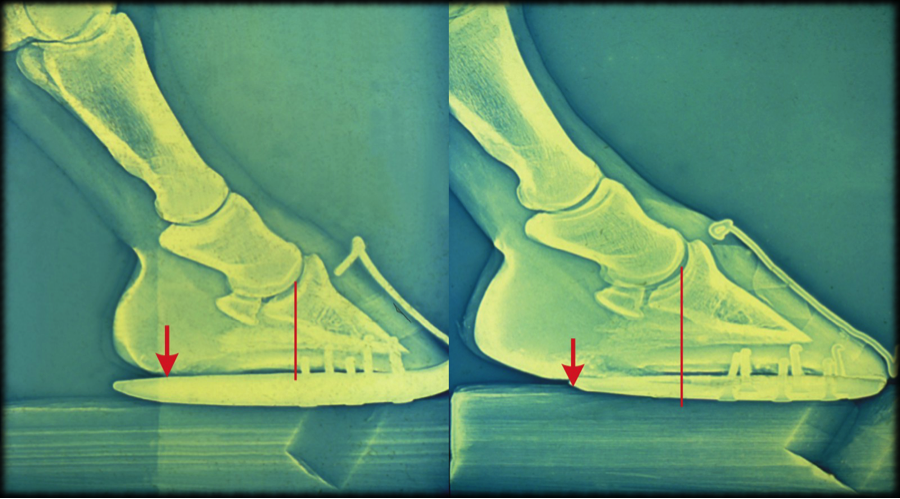Shoeing can make a great deal of difference in relieving pain in horses’ feet relatively quickly, but it’s important to avoid being overly ambitious, says Welsh farrier Grant Moon.
“I went through a period when I thought I could fix anything with one trim,” he says. “I stripped feet and I weakened feet.”
Now, his philosophy is a bit different.
“I believe you have to leave enough foot integrity when you trim,” Moon says, “so that the horse is not foot sore.”
So when a horse with sore heels arrived at his door, he had X-rays taken to find out what was going on. By drawing a vertical line at the center of articulation, Moon discovered that there was too much heel.
“When that foot lands on the ground on a soft surface, the heels are going to sink in a little,” the world champion farrier says. “That will tighten the deep flexor tendon. You’ve got all this leverage, which will cause resistance to breakover. It’s going to cause another tightening of the deep flexor tendon.”
In addition, the last point of weight bearing is over the wing of the coffin bone, where concussion is entering, as well as in the navicular area. The joints at the ends of the long pastern bone and the short pastern bone also are being pinched.

A horse with sore heels, right, has more than 50% of its foot behind the center of articulation. The last point of weight bearing is right over the wing of the coffin bone, which means that concussion is entering there and over the navicular area. The pastern joints also are experiencing pinching. One hour after a new trim and shoeing, left, the foot demonstrates improvement. The center is closer to 50/50, the joints are improved, and the last point of weight bearing is well behind the wing of the coffin bone. Photo courtesy of Grant Moon
“The whole mechanics of the bottom of the foot are probably aggravating it,” Moon says.
While it might be tempting to repair the foot in one trim, Moon suggests taking a more measured approach.
“When I look at this, that foot trim probably didn’t go wrong in one trimming,” he says. “Why should I fix it in one trimming? Why can’t I improve it? Why can’t I make a 70% or 80% improvement? Then get a little bit more next time, and a little bit more the time after. I might have to strip the hoof wall if I want to fix it, but I wanted to leave the horse with something to stand on.”
An hour later, a second X-ray is taken, which reveals that the 50/50 split at the center of articulation is improved, as are the joints at the pasterns.
“I stuck a bit of shoe on the end to give it a bit of posterior support,” Moon explains. “If you draw a line at the last point of weight bearing, it’s way behind the wing of the coffin bone and way behind the navicular bone. So concussion is going to function much better. This horse didn’t leave sound, but it went out 75% better, just through shoeing.”








Post a comment
Report Abusive Comment